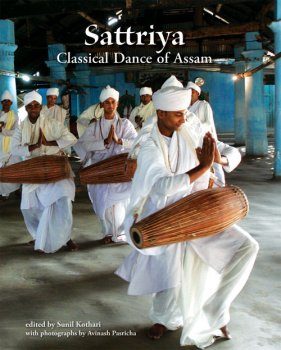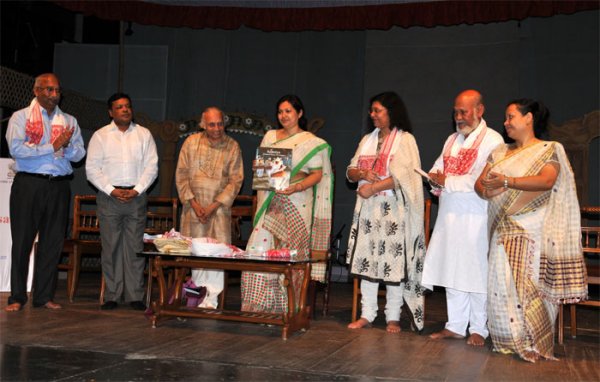
|   |

|   |
Book launch of ‘Sattriya: Classical Dance of Assam’ - Raju Das e-mail: rajusna@yahoo.co.in April 24, 2013 At Sattriya Kendra, we were all awaiting the publication of ‘Sattriya: Classical Dance of Assam,’ a book edited by Dr. Sunil Kothari, with photographs by Avinash Pasricha, published by The Marg Foundation, Mumbai. Dr. Kothari was working on this book for the past several years. Therefore, when we received the news that The Marg Foundation and the Department of Culture, Govt. of Assam will have release and the book launch function in Guwahati by the Hon’ble Chief Minister Shri Tarun Gogoi on 10th April 2013, we were all delighted. By a happy coincidence, Sattriya Kendra was also staging the Ankiya Bhaona play ‘Sri Ram Vijoy’ by Sankardeva, produced by Sattriya Kendra and directed by Dulal Roy, Director of Sattriya Kendra, the same evening after the formal book launch.  On account of the Majuli Festival which was on at Majuli Island, elaborate celebrations were going on there. On arriving from the Capital, the Chief Minister had to rush to Majuli Island. Therefore he sent a word to the Principal Secretary, Kumar Sanjay Krishna, that the chief guest for the event Pranatee Phukan, Minister for Culture, Govt. of Assam, would release the book. He also sent his message for the successful book launch. By 5pm, the hall was packed. Dignitaries included the Pramukh of Sattra Mahasabha, gurus Jatin Goswami, Ghanakanta Bora, Sailen Saikia, Gobinda Saikia, Ramakrishna Talukdar with their disciples, Provakar, son of Guru Jatin Goswami, performing artistes Indira PP Bora, with PP Bora, Sharodi Saikia, currently Director of Sankaradeva Kalakshetra, Mallika Kandali, Anita Sharma, Gayatri Baruah Sharma, Anjana Moyee Saikia and several other dancers. Among the senior scholars Dr. Keshavananda Dev Goswami was present, so were many young dancers. Each guest on stage was offered Gamosa by Director Madhuri Barua Sen, after which they were requested to light the lamp, when traditional prayer along with playing of the drums by the Gayan Bayan party of ‘Sri Ram Vijoy’ Ankia Bhaona was recited. It was a simple and dignified serene beginning befitting the event. Rajkhowa, from Dept of Culture, welcomed all and outlined the details of the program. After the few preliminary remarks, Raka Datta, Regional Director of The Marg Foundation of Eastern India, gave a brief introduction to Marg magazine started by Dr. Mulk Raj Anand in 1946, dedicated to revealing lesser known facets of the world of Indian arts. It is supported by Sir Dorabji Tata Trust and allied Trusts. The present volume of ‘Sattriya: Classical Dance of Assam’ has been made possible by generous support received from the Sir Ratan Tata Trust and the Navjibai Ratan Tata Trust and also from Sangeet Natak Akademi. In the past 63 years, it has brought out several volumes of the quarterly journal and also books, which have received international reputation in terms of its academic scholarly content and high production values. After Dr. Pratapaditya Pal retired, Dr. Vidya Dehejia is the present editor. She said The Marg Foundation feels privileged to have brought out a special volume on the classical dance of Assam. 
From left: Swapananil Barua (Commissioner, Dept of Culture), Kumar
Sanjeev Krishna (Principal Secretary, Govt of Assam), Dr. Sunil Kothari,
editor of the book, Pranatee Phukon (Minister for Culture, Govt of
Assam), Raka Datta (Regional Director Eastern India, Marg), Dulal Roy
(Director, Sattriya Kendra), Madhuri Barua Sen (Director, Dept of
Culture, Govt of Assam)
Dulal Roy, Director of Sattriya Kendra, introduced Dr. Sunil Kothari, having known him for past more than 40 years. He mentioned Dr. Kothari’s books on Bharatanatyam, Kathak, Odissi, Kuchipudi and several other publications and his regular columns in the Times of India group of newspapers, his services as a dance critic and deep research and scholarship. Complimenting him for his lifelong interest in performing arts and dance in particular, he praised Dr. Kothari’s efforts to highlight the culture of Assam and his several visits to Majuli Island for study of Sattriya dance, close association with Dr. Maheswar Neog, Dr. Bhupen Hazarika, Dr. Pradip Chaliha, and various lecture - demonstrations Dr. Kothari gave along with late Raseshwar Saikia, present guru Ghanakanta Bora and Indira PP Bora, before Sattriya was recognized as classical dance in the year 2000. Striking a personal note, he referred to Dr. Kothari’s close friendship and association with renowned director Ratan Thiyam and his Chorus Repertory Theatre and Dr. Kothari’s interest in Assamese theatre. Introducing the book, Dr. Kothari spoke of his indebtedness to Dr. Mulk Raj Anand, Prof. Mohan Khokar and Dr. Maheswar Neog, who encouraged him to visit Assam and study the dance form by visiting various sattras, observing various classical dance forms, how he along with other scholars felt that Sattriya dances had all the elements to qualify it as classical dance form. Enlisting support from the Assamese scholars including Dr. KD Goswami, Dr. Jagannath Mahanta, Dr. Pradip Jyoti Mahanta, gurus Jatin Goswami, Ghanakanta Bora, Karuna Bora, dancers Sharodi Saikia, Dr. Mallika Kandali, young dancers Menaka PP Bora and Anwesa Mahanta, he said he has attempted to have the voice of Assamese scholars and gurus and young exponents in the book, which presents a comprehensive picture of the present state of Sattriya dance with historical account by scholars like Dr. Maheswar Neog. He thanked photographer Avinash Pasricha for travelling with him and taking hundreds of photographs, some of which illustrate the book. He also thanked Swapnanil Barua, Commissioner for Culture and Sattriya exponent Anita Sharma and her husband Samar for continuous support for past five years during his visits to Assam. He also thanked Sangeet Natak Akademi, Sattriya Kendra, Dulal Roy and all who lent several facilities for without their support such a book would not have been possible. He said that he was happy that he has fulfilled the debt he owed to Dr. Maheswar Neog and finally the book has been released. Pranatee Phukan, Minister for Culture, while releasing the book spoke of the great tradition of Sattra, the philosophy propagated by Sankaradeva, the ground exercises, the monks master, the spirit of bhakti and the great legacy of dance and allied arts. She congratulated Dr. Kothari and Marg Publications for bringing out such a handsome volume on Sattriya dance. Swapnanil Barua, Commissioner of Culture, expressed his thanks to Dulal Roy for staging the play ‘Sri Ram Vijoy’ on the occasion and hoped that Dept of Culture would continue to support such artistic activities and wished The Marg Foundation more success in bringing out such highly academic and artistic works. He also assured all that the book on Sattriya dance would find a place of pride in Assam. After a brief interval, the Ankiya Bhaona was staged to the full house. Next day on the 11th April, a reception was arranged for Dr. Sunil Kothari, Raka Datta and all the artistes who had taken part in the Ankiya Bhaona ‘Sri Ram Vijoy.’ Dr. Kothari shared with all how he was inspired to start his career as a research scholar, giving up his career as a Chartered Accountant, and did his Ph.D in dance. Since 1958 when he visited All India Dance Seminar, his life changed. Dr. Mulk Raj Anand advised him to undertake researches on Indian classical dance. In that work, he received Dr. Maheswar Neog’s support for Sattriya dance. In those years, very few had visited Majuli Island and very little was known about this great tradition of Assam. He further observed that even after it has received recognition as eighth classical dance form, very few know about it outside Assam though with establishment of Sattriya Kendra by Sangeet Natak Akademi, awareness has been generated. In that direction Sattriya Kendra and Sangeet Natak Akademi are very active. He hoped that the book he has edited would also be helpful. After the reception, the artistes performed Bihu dance of Assam. Raju Das is the Secretary, Sattriya Kendra, Guwahati. |